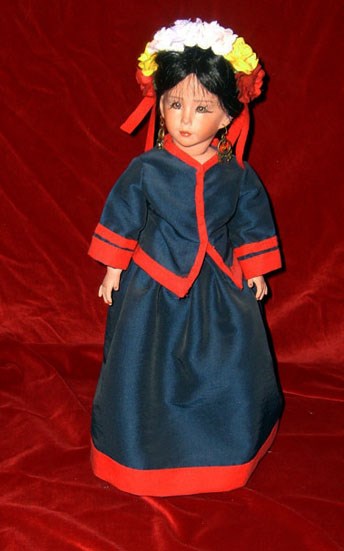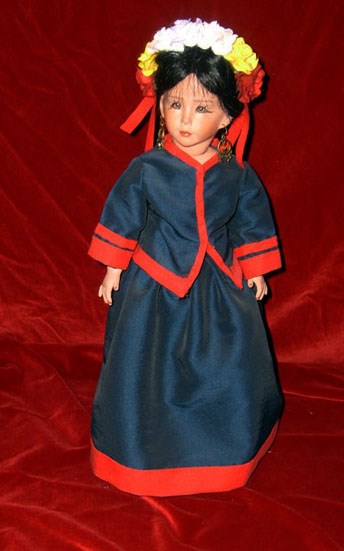
Capital: Cuernavaca The deep blue jacket and skirt with broad red edging are elegantly simple. Morelos is one of Mexico's smallest states. The Nahuas are the largest group of indigenous people in the country of Mexico, numbering well over a million. The majority of the Nahuas are concentrated in the states of Morelos, Puebla, Tlaxcala, and Mexico. Seven different tribes recognized as Nahuatlacas speak Nahuatl, also known as Mexicano. The Nahuas carried the powerful influence of the Aztec culture through the Spanish conquest and into modern day Mexico where they have both integrated with the general population and maintained their dedication to successfully cultivating their native soil. The Tlahuica were also one of the Aztec peoples of central Mexico at the time of the Spanish conquest (1521 AD) who lived in the area that is now the state of Morelos. Known as la ruta de los balnearios (the bathers' route), Morelos makes the most of its abundant rivers and springs and moderate climate, attracting visitors - especially residents of Mexico City - to its many refreshing water parks, thermal baths, and mineral springs. Some resorts are located in former convents and monasteries. During Carnival, the traditional dance of the chinelos is extremely popular. Dancers dress in long tunics, cover their faces with masks, and wear tall headdresses adorned with mirrors and colorful beads. The Transversal Volcanic Sierra, also known as the Sierra del Centro, is an enormous mountain range stretching across Morelos' northern and eastern borders. To the north, the Chichinautzin biological corridor is dedicated to the protection and preservation of plants and animals, like the teporingo, a small rabbit with short round ears, which is on the list of species facing extinction. The state's industry has profited from proximity to Mexico City, but in 1963, Morelos formed its own industrial zone, CIVAC - the Cuernavaca Valley Industrial Corridor - to separate local industry from the capital. The well-known slogan that appears around the border of Morelos' state emblem, "The land will be returned to those who work it with their hands," was coined by the famous Morelos revolutionary leader, Emiliano Zapata. Did you know...? 
Capital: Cuernavaca La chaqueta azul oscuro y la falda con el amplio borde rojo son sencillas y elegantes. Morelos es uno de los estados más pequeñnos de México. Los Nahuas son el grupo indígena más numeroso de México, con más de un millón de habitantes. La mayoría de Los Nahuas se concentran en los estados de Morelos, Puebla, Tlaxcala, y México. Siete tribus diferentes reconocidas como Nahuatlacas hablan Náhuatl. Este grupo indígena ha conservado la influencia de la cultura azteca a pesar de la conquista española y ha permanecido hasta nuestros días donde se han integrado a la población general manteniendo una conexión con sus raíces. Los Tlahuica son también uno de los pueblos aztecas que habitaban el centro de México durante la conquista española. Conocida como la ruta de los balnearios, Morelos atrae a visitantes con sus abundantes ríos y su clima templado, sobre todo los residentes de la Ciudad de México, con parques de aguas refrescantes, termales y minerales. Algunos de los antiguos conventos y monasterios se han transformado en atractivos complejos turísticos. Durante el carnaval (tres días antes del miércoles de ceniza), el tradicional baile del chinelo es sumamente popular. Los bailarines se visten con túnicas largas, cubren sus caras con máscaras y llevan altos tocados adornados con espejos y cuentas vistosas. La Sierra Transversal Volcánica, también conocida como Sierra del Centro, es una enorme sierra localizada en la frontera noreste de Morelos. Al norte, el corredor biológico Chichinautzin está dedicado a la protección y preservación de plantas y animales, como el teporingo, un pequeño conejo de orejas cortas y redondas, está en la lista de especies en peligro de extinción. La industria del estado se ha beneficiado por la proximidad con la Ciudad de México, pero en 1963, Morelos formó su propia zona industrial: Corredor Industrial del Valle de Cuernavaca (CIVAC), para separar la industria local de la capital. El conocido lema que aparece alrededor del escudo de armas del estado de Morelos, "la tierra es de quien la trabaja", fue acuñado por el famoso líder de la revolución, Emiliano Zapata, nativo de Morelos. Sabías que...? |
Last updated: February 24, 2015
